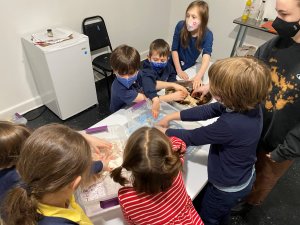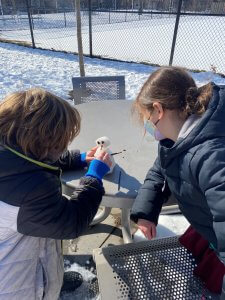This week we explored how tallitot, tzitzit, and other ritual objects empower us and act as a reminder to make good choices. Throughout the week we wrapped ourselves in tallitot, tied knots, and wove together ideas about connection.

As we dove into the topic of making good choices, we looked to our own space and considered what supports we rely on to make good choices here at Makom. One major support we use at Makom is the Pinat Shalom (Peace Corner). We inquired with the group: how do we use the Pinat Shalom and how can we make it work even better for us?

Kiddos brainstormed a large list of ideas and we noticed three major themes:
- There are expectations for how we should use the Pinat Shalom.
- Kiddos use the Pinat Shlom for different reasons.
- The things found in the Pinat Shalom are important tools we use to support ourselves.
After our brainstorming, learners joined a group to work on enhancing an aspect of the Pinat Shalom.

The first group wordsmithed our list into three clear community expectations and wrote them out to display on the wall.
“If you are going to the Pinat Shalom in the first place you might be mad or sad, that is a person who might break a rule.” An impassioned student explained.

“Well, we all break rules sometimes, especially when we are having a hard time. Do you think it helps someone who is mad or sad to have clear expectations laid out for them so they know what to do?” I asked.
“Well, it doesn’t feel good to be told what to do.” They countered.
“You are a smart bunch of kids who just came up with a long list of your own ideas of how we can use the Pinat Shalom” I replied.
Together we looked at the list and circled what we thought sounded reasonable. Then we consolidated similar ideas. We decided that the key was to phrase the community expectations in a non-demanding way.
“How would you like to learn or be reminded of these expectations?” I asked.
The students came back to me with three ideas. They then wrote/ illustrated them on a poster to hang on the wall:
- Have a safe, calm body.
- Come back when you are ready.
- Be kind, share space, no yelling.
The second group of engineers figured out how to put together a tent that they had requested back when we first moved into S. Juniper St. They were so excited to get started and have their request granted.

Without any instructions, they worked together. As we observed, we overheard thoughtful, collaborative problem-solving.
“These bars look like they should cross over each other, can you hold one end?” One learner asked another.
“The pole fits here! This must be the way!” Another kiddo exclaimed. Once the tent was complete, we discussed how it could be used. “What would help this tent work for the whole group?” We asked the engineers.
“If we all go inside at once it won’t be safe” a thoughtful kiddo explained.

After snapping a group photo, the learners decided together that only two people should be allowed in the tent at once. We also decided that the tent is a great place for kiddos to go if they need some alone time. The open area in the Pinat Shalom works well for several kiddos to use at once as they are engaged in calming activities. The tent works well as a place for someone who really needs their own zone to calm down.
The third group considered what items should live in the Pinat Shalom.
We imagined what we like to do to have a calm and safe body:
- Read books
- Write/draw
- Play with Legos
- Hold fidgets and small toys
- Take a breath
- Making shapes with your body
We looked at the list again and narrowed it down. We decided that although Legos help some of us calm down they might energize others in a way that is not productive. One kiddo offered that they “don’t think we should have anything hard in the Pinat Shalom.” Another learner said that making shapes with his body helps him to calm down. “We should have cards that show different shapes you can make!” He exclaimed. While one team gathered fidgets and small toys, the other labeled the bins and helped create the shape-cards.

Our Pinat Shalom is now home to a number of amazing calming resources including natural materials to hold and fidget with, books, upcycled paper notebooks, and self-regulation tools.
Next week we look forward to wrapping up our Holy Me unit with a review of our favorite texts and projects about nurturing the light around us so that we can grow.

